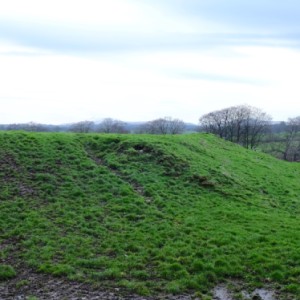A few stones in a field . . .
. . . not quite.
When Michael Mullett spoke about the history of Penrith yesterday, he mentioned two Roman forts that pre-dated the town by a long way – one to the south where Brougham Castle is now and one to the north at Plumpton. Whilst I knew the latter was there I had never been to see the site so today, as we had to go up to Carlisle anyway, we decided to go via the A6 and seek it out. I had not expected to find anything more than a field with a few ‘bumps’, I was surprised.
We parked the car at the farm (appropriately called Castlesteads) where the Fort was marked on the map. There did not seem to be anything there but some fields with ‘bumps’. Then we got into conversation with a young farmer and how brilliant was he. He told us all about the Fort and where to find evidence of it. He told us about how English Heritage had drawn a circle within which they could not build, how they had had to concrete (at English Heritage’s expense) over areas of high tractor, cattle traffic so as to protect what lay below. So full of information he was.
When we crossed the road, as directed, this is what we found – a few stones in a field. No! These are the remains of the gateway into the Roman Fort. The extra photo taken further along the road shows how the fort was built upon a stone platform, most of which is still there under the grass. The aerial photo here shows the whole site.
This was a major fort called Voreda, along the Roman road between York and Carlisle (the A6 follows the route of the Roman road) and had a huge civic settlement beside it. There is evidence that around 2,000 people lived here between the 1st and 4th centuries. No wonder locals called it Old Penrith. Lots of things have been found here – engraved stones, coins, pottery, most of which is now in the Tullie House Museum in Carlisle. Our farmer friend told us how they are often finding coins and bits of pottery. How cool is that!


Comments
Sign in or get an account to comment.


